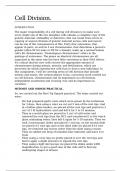Cell Division.
INTRODUCTION.
The major responsibility of a cell during cell division is to make sure
every single one of the two daughter cells obtains a complete copy of the
genetic material. Unhealthy or defective cells can result from errors in
copying or uneven division of genetic material across cells and cancer
can be one of the consequences of this. Forty-four autosomes, that
appear in pairs, as well as 2 sex chromosomes, that determine a person's
gender (often XY for male or XX for a female), make up a normal human
cell's 46 chromosomes. "Homologous chromosomes" refers to the
pairings of autosomes. The genes on identical chromosomes are all
organized in the same way but have little variations in their DNA letters.
It's critical that the new cells receive the appropriate amount of
chromosomes during mitosis, meiosis, and fertilisation, which are
processes by which reproductive cells fuse to form a new individual. In
this assignment, I will be covering areas of cell division that include
mitosis and miosis, the various phases it has, a practical work carried out
on cell division, chromosomes and its importance on cell division,
independent assortment and crossing over and its importance in
variation.
MITOSIS AND MIOSIS PRACTICAL.
So, we carried out the Root Tip Squash practical. The steps carried out
were:
- We had prepared garlic roots which were grown by the technician
for 3 days, then using a ruler we cut out 5 mm of the root tips. And
in a hollow glass beaker, we placed all the root tips and poured in 2
cm3 of 1 M hydrochloric acid and left it for 5 to 10 minutes.
- Then in a watch glass we poured in 5 cm3 of cold water and
removed the root tips from the HCL and transferred it to the watch
glass containing water, then left it again for 5-10 minutes. Then we
took 3 microscopic slides and placed 1 root tip, on the second slide
we placed 4-5 root tips and on the third slide we placed 8-10 root
tips, we removed any excess water from the slide using a tissue.
Then we added one drop of toluidine blue indicator and leave it to
stain.
- Then using a cover slip we gently placed it over the root tips and
had to apply a slight pressure to squash the root tips.
- Then using a light microscope we placed the slides under x400
magnification, to get a good view of the cells and to find any
undergoing stages of mitosis.
, When we looked at the slides, the first one with one root tip, was not
very clear, and had a lot of air bubbles and was stained too much, so
we did not get any results or good view. In the second root tip slide
with 4-5 root tips, the cells were overlapped and there were again air
bubbles, it was not really clear and we could not observe the cells very
well. In the third slide with around 8-10 root tips, we could see the
cells but we could not find any undergoing mitosis or cell division.
There were some air bubbles, but not as many as the first slide.
The errors caused in this practical could be due to not having a
microscope that has a higher magnification, for a more clearer look at
the cell nucleus, as the microscope used could not give us a more
closer look at the cells, another factor would be if we could have used
maybe different root tips of the garlic clove, instead of using samples
from one garlic clove, using another garlic clove root tips may have
given a better result. Additionally, another factor could have been
because we did not incubate the root tips in HCL from the first step
above in a water bath at 60 degrees Celsius and this may have
affected the results we obtained. Another factor could be because we
did not use a mounted needle for maceration which resulted in having
air bubbles, cells sliding over each other in layers and so not getting a
good view of cell division. One last factor that could have affected the
results would be that once we used a cover slip and pressed over the
slip to mask the root tips, the cover slip may have moved, therefore
sliding the cells over one another getting layers. These factors may
have affected the results and so I did not get the desired view, or
expected outcomes.
[The image above shows the light microscope, hollow glass and glass watch
with root tips and one root tip squash stained slide].
, [This image above, shows the interphase, early prophase, metaphase, anaphase
and telophase stages shown by the standard mitosis slide by the light
microscope.]
[This image above shows the light microscope images of the 1 root tip squash,
the 4-5 root tip squash, and the 8-10 root tip squash prepared slides.]




